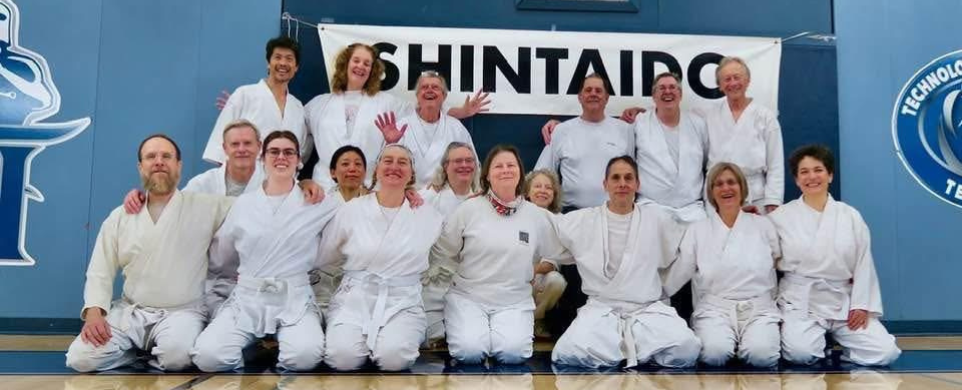by Byron Russell
Over the 2025 Martin Luther King Jr. weekend, Pacific Shintaido hosted its annual Kangeiko workshop in the Technology Middle School gymnasium in Rhonert Park, California.
General Instructors Shin Aoki and David Franklin led the four keiko, guiding us through a curriculum that addressed PacShin’s 2025 theme, No Separate Self. Shin Sensei acted as Director of Instruction for the event with David Sensei as our Guest Instructor visiting from the Czech Republic.
By inviting David Sensei and Shin Sensei to instruct, the Pacific Shintaido board (Shin Aoki, Cheryl Williams, and Derk Richardson) sought to provide them with the opportunity to share glimmerings from their recent international travels to Dokan ’24 in England, as well as to recognize their accomplishments in the International exams offered there.
Derk Richardson and Cheryl Williams acted as co-organizers of the event, and Derk read the following quotations and comments as part of his opening remarks:
Masashi Minagawa Sensei’s thoughts on Kangeiko:
“Kangeiko means cold Keiko. The reason we practice at a cold time is that when we face great nature, we realize how powerless and small we are. We try to find nature within ourselves. Through this, we can try to awaken our sleeping potential self. It is a challenge to try to get rid of our old self and find a new beginning.
At New Year we refresh our old selves and go back to the original beginner’s mind. Then we celebrate the coming year and ask for health and happiness.
At Kangeiko especially, we try to find the real existence, our own nature inside ourselves.”
Derk continued with thoughts from the PacShin board on the chosen theme:
“We chose our theme this year, “No Separate Self,” not as a foundation for any specific curriculum, but, rather, as something like a riddle or a koan, something to roll around in your brain, tumble in your consciousness, feel in your body. We were inspired by the recognition of how separated we often are from one another, increasingly from nature and the environment, and definitely by seemingly intractable economic, social, and political divisions. And how much suffering we engender in our lives and in the world through our clinging to the notion of our separate self.
“Inspiration also came from the late Buddhist teacher and writer Thich Nhat Hanh, who, when describing “emptiness,” one of the three characteristics of existence, along with suffering and impermanence, defined it as being empty of any separate self. “The Heart Sutra,” he wrote, “teaches us that form may be empty of self but it’s full of everything else.”
“A wave on the ocean has a beginning and an end, a birth and a death,” he wrote. “But Avalokiteshvara tells us that the wave is empty. The wave is full of water, but it is empty of a separate self. A wave is a form that has been made possible, thanks to the existence of wind and water. If a wave only sees its form, with its beginning and end, it will be afraid of birth and death. But if the wave sees that it is water and identifies itself with the water, then it will be emancipated from birth and death. Each wave is born and is going to die, but the water is free from birth and death.”
He finished his introductory comments with this set of quotations:
“In the Vietnamese literary canon, there are two lines of poetry by the twelfth-century Zen master Khánh Hỷ of the Ly dynasty that say:
“If the cosmos exists, then the smallest speck of dust exists.
If the smallest speck of dust doesn’t exist, then the whole cosmos doesn’t exist.”“Were mind and matter me, I would come and go like them. If I were something else, they would say nothing about me. —NĀGĀRJUNA, Mūlamadhyamakakārikā or Fundamental Verses on the Middle Way
“Instead of separate, discrete entities, everything is flowing, interacting, and impinging on each other. We and the sun and the trees, all is perpetual flowing.”
Joanna Macy, “Positive Disintegration”
For those interested in additional information on these writers, more can be found at the following links:
Thich Nhat Hanh, “The First Door of Liberation”
Thich Nhat Hanh, “The Moon Is Always the Moon”
Susan Kahn, “No Separate Self”
Stephen Batchelor, “After Buddhism: Rethinking the Dharma for a Secular Age“
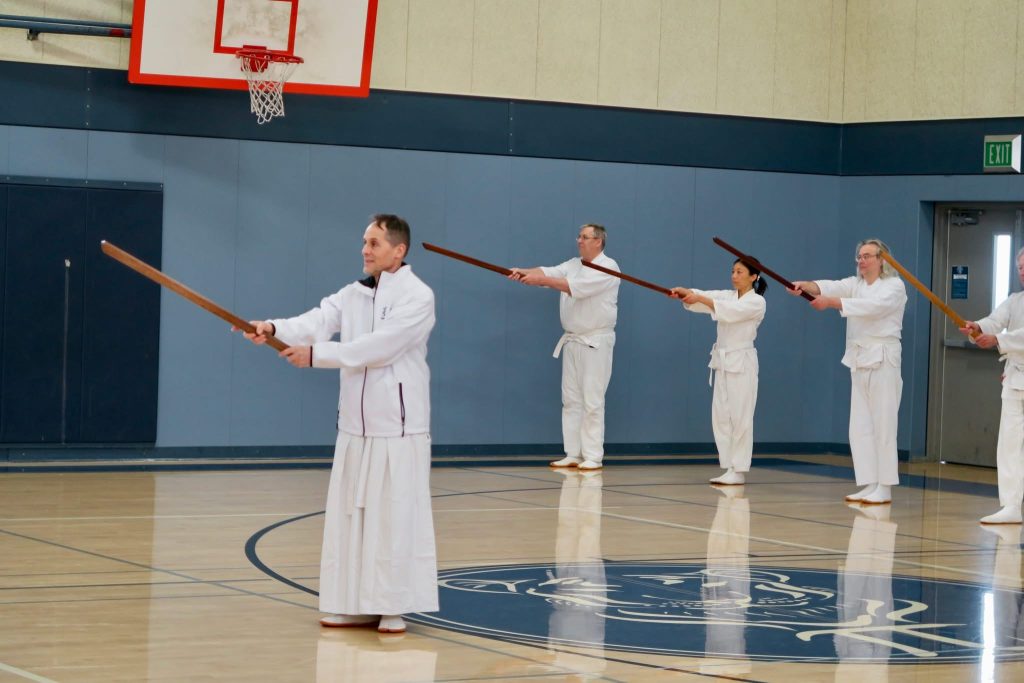
Over twenty Shintaido practitioners, from the greater San Francisco Bay Area as well as Oregon, Florida, and the Northeast, participated during the weekend. Each keiko was taught entirely by one instructor. On Saturday morning, after Martha Rodriguez led warmups, Shin Sensei led the class through tachi jumping, wakame kumite, and Eiko Dai with bokutoh around the gym. The keiko then focused on tenshingoso applications using bokutoh, including partner practice with the idea of receiving with wakame feeling and then an immediate counterattack–filling the vacuum left by the passing of the attacker’s sword. Shin sensei finished his instruction with Standing Meditation: Poses #1 through #5, visualizing unification inspired by the theme, “No Separate Self”:
#1 unification with earth;
#2 unification with people;
#3 unification with world and nature;
#4 unification with heaven/spiritual world;
#5 unification with self.
After a midday potluck brunch hosted by Nicole Masters at her home in Cotati, the gasshuku continued with David Franklin Sensei leading both warm-ups and a free-hand and bokutoh class inspired by renki kumite. The class began with sumo walking focused on a wide stance with feet gliding smoothly across the floor. David Sensei continued with a 3-person wakame exercise, one leader as wave and two partners as wakame, and then with Daijodan Kirikomi. The breakout portion ended with “Sandpipers vs Wave” that had the Shintaido practitioners as a tight group acting as sandpipers while one from the group acted as the ocean wave (opening back with ‘ah’ and cutting forward with ‘eh’), either gentle or strong, slow or rapid. This continued the vacuum idea from Shin Sensei’s previous keiko.
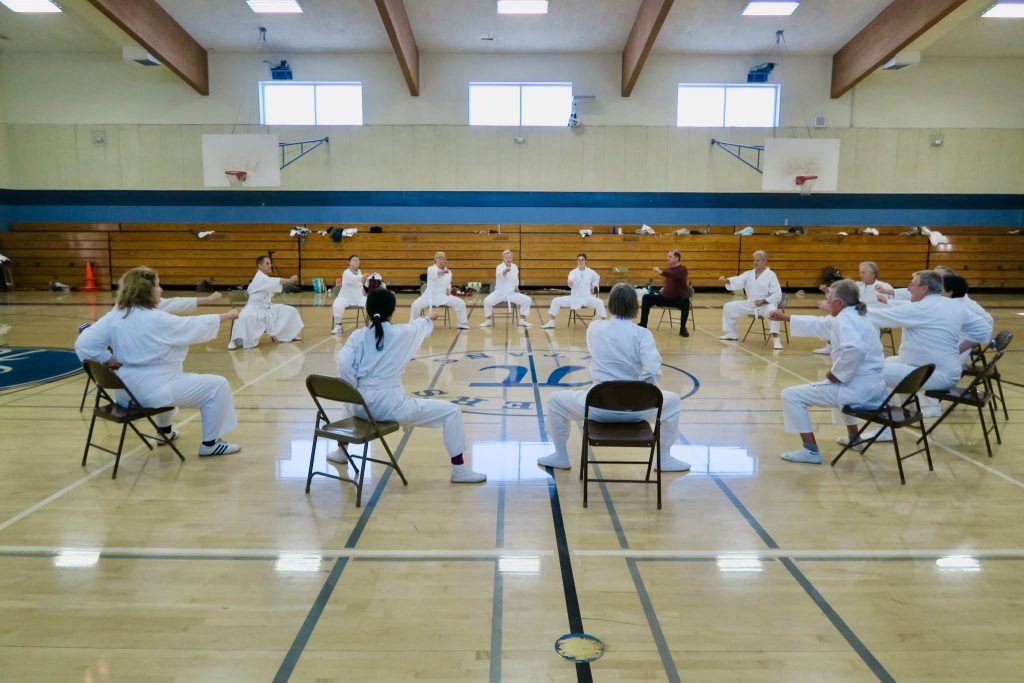
David Sensei continued with chair exercises. The keiko participants were asked to form a circle of chairs and then perform chudan tsuiki on kibadachi either fully resting on the chair or floating slightly above, based on their body condition and comfort level, followed by the same exercise using gyakuzuki, from the seated position to standing up. This was followed by four renki kumite exercises with partner:
(1) hooking with fingers
(2) fingertips barely hooking
(3) palm to palm, pushing toward the partner’s center
(4) tsuki vs cupping hand.
The keiko ended with a meditation exercise (Hoten and Hokushin) and then a timing exercise with three people. In the first variation, person A performed Daijodan Kirikomi; person B Chudan tsuki; while person C acted as the “starter” who signaled to person A when to cut person B. In the second variation, person A performed Daijodan Kirikomi; person B faced away from person A to do Chudan-zuki. Person C was tasked to anticipate A’s cut and give a signal to person B with sufficient time to avoid being cut from behind. A demo of San-Nin-Ichiretsu by Senseis David Franklin, Jennifer Perringer, and Robert Gaston ended the keiko.
About half the participants joined for dinner at a local Greek restaurant in the evening.
On Sunday morning, Sally Gaston led warmups for David Sensei’s second keiko that continued the development of his renki-inspired bokutoh and free-hand curriculum. A central idea of this keiko was Zeno’s Dichotomy Paradox and thus the infinite reach of shoko or a tsuki. The Renki Kumite variations consisted of:
(1) “Shake hands”
(2) Connection through the ulnar side of the wrists
(3) Connection using both hands (right and left)
(4) Two hand connection in a group of three
(5) Connection with gyakuzuki vs. palm; tsuki person aimed toward the center of the opponent and chased the center while the opponent received and deflected.
The keiko was followed by a second potluck hosted again by Nicole Masters.
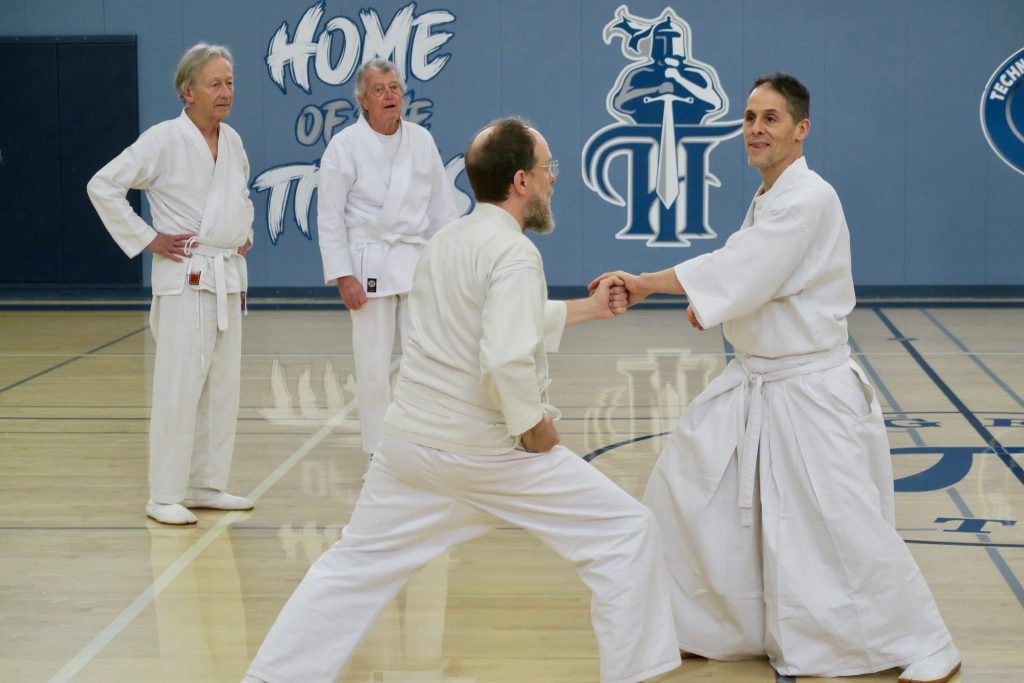
The final keiko combined elements of the first three keiko. David Sensei began with a chudan honzuki practice that focused on a step forward using the front foot. The goal was to give no anticipatory or preparatory movement. This was followed by variations of timing practice:
(1) Tsuki vs receiving w/ palm
(2) Receiver stepping back at timing B (pushing and receiving happen at the same timing)
(3) Receiver stepping back at timing A (receiving happens slightly before the push)
(4) A group of three: Attacker, Receiver, and “starter.”
This was followed by bokutoh or free-hand practice (Daijidan-Kirikomi, Seichu-ken (Kyukajo #4A)) and then Kumitachi (Kyukajo #4A – Daijodan vs Seichu-ken). The kieko ended with a wakame and tenshingoso inspired version of Renki Kumite using both hands (right and left) at the same time, ulnar and radial sides changed freely, in three variations:
(1) with two people
(2) in a group of three
(3) with everybody together in a circle.
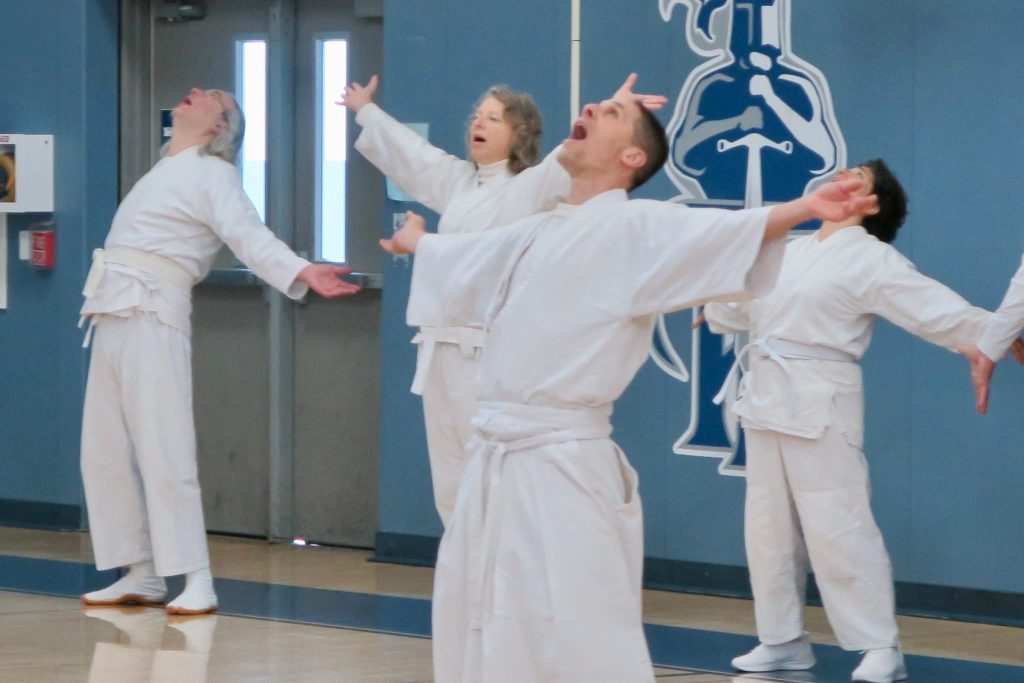
In the closing ceremony, a final note was given to the theme of “No Separate Self” when Nicole Masters read this passage.
“I received this when my husband passed 3 1/2 years ago. It has given me comfort and inspiration that, I will dance again. It has been a hard road but the music of life is finally moving through me again. Having Kangeiko at my home was a wonderful life-embracing experience for me.”
“Someday you will be faced with the reality of loss. And as life goes on, days rolling into nights, it will become clear that you never really stop missing someone special who’s gone, you just learn to live around the gaping hole of their absence. When you lose someone you can’t imagine living without, your heart breaks wide open, and the bad news is you never completely get over the loss. You will never forget them. However, in a backward way, this is also the good news. They will live on in the warmth of your broken heart that doesn’t fully heal back up, and you will continue to grow and experience life, even with your wound. It’s like a badly broken ankle that never heals perfectly, and that still hurts when you dance, but you dance anyway with a slight limp, and this limp just adds depth to your performance and the authenticity of your character. The people you lose remain a part of you. Remember them and always cherish the good moments spent with them.” Author Unknown

